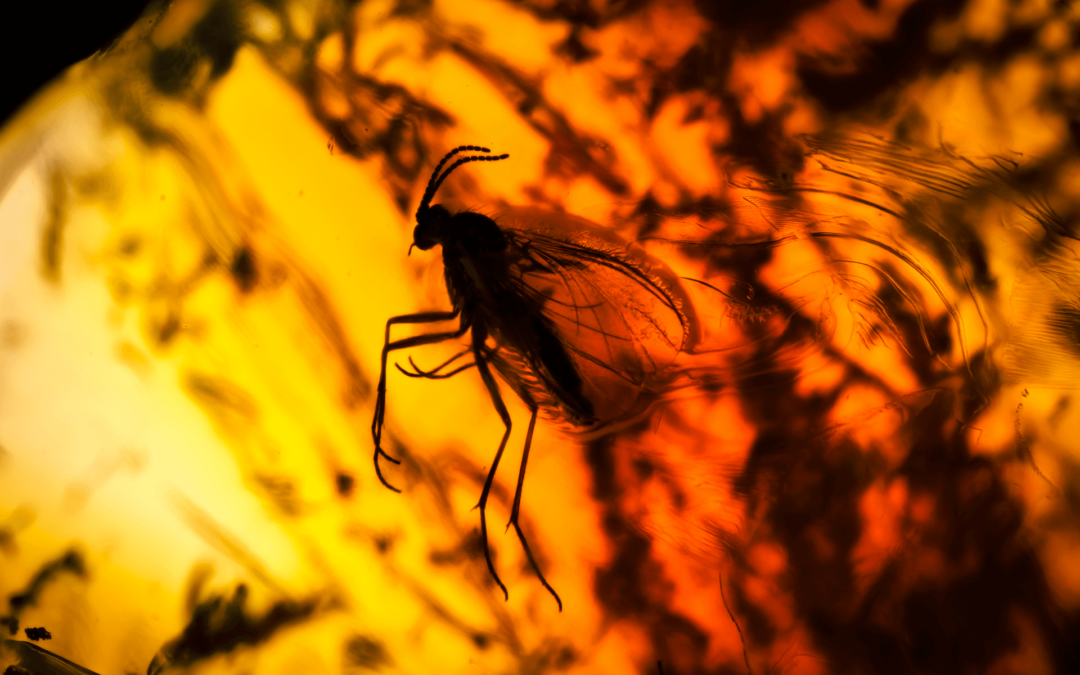Occasionally as we become engrossed in a gem material that may be new, or at least partially new, to us, and particularly today when we are blessed with instrumentation that allows us to delve ever deeper into the origins. It is good to reflect back a few hundred years and learn from the amazing observational skills of our forefathers. Such is the case here where we have become intrigued (again) by inclusions within amber.
“Dr. John Fothergill was born at Carr -End, Yorkshire, England in 17I2 and died in 1780, a relatively short life in today’s terms. He was of the Society of Quakers (as was the world-famous gemmologist B.W Anderson [1901 – 1984]). After he had gone through his grammatical education, he was apprenticed with an apothecary and when the term of his apprenticeship had expired he went to study physic at Edinburgh”. His biography reveals a person who loved to study and try to understand nature – he was a member of the Royal Society (RS), – “after acquiring a large fortune, he planted botanical gardens which in the course of a few years was stored with rarest exotics from all parts of the world”. “Without possessing the talents of a very brilliant or superior kind Dr F. attained the highest distinction in his profession”.
Of the many interests in nature that he pursued, one was the determination of the origins of amber, here he records that “on the origin of the facts is built a discussion of the following problems”
-
Whether amber is not strictly a marine production; or is reduced by some quality of the sea water into the condition we find it in. Or,
-
Whether it is not to be considered only a bituminous body, generated in the bowels of the earth? Or, lastly,
-
Whether it is not, in its origin, a vegetable production, a resin; but changed into its present form by a mineral acid?
“It will only be necessary, in this place, to mention, that after having shown the difficulty of maintaining the first two, he has undertaken to support the last of these options”.
“He endeavours to make it appear, that amber was original- ly a vegetable resin: the product perhaps of the fir or pine kind” (Fothergill, 1809).
And so, it shows by the simplest, but detailed observation, that an enthusiast in the 1700’s set us clearly on the correct path towards understanding origin of this important gem material.

Figure 15
An insect in amber from the collection of Kenneth Scarratt. Photo by Victoria Raynaud.
In modern times Norbat Vávra speaks to the definitions of fossil resins, amber and copal with some clarity (VáVra, 2009), here he states that the term resin is a – “collective term for a group of solid or semisolid organic substances, showing differences in respect to their chemistry but similarities in respect to a number of physical properties”. He goes on to state “The term ‘amber’ is also mostly regarded as a collective term including solidified resins of various origin, composition, colour, etc. Ambers are at any case the result of fossilization, a process beginning with polymerization yielding often a cross-linked copolymer subject to progressive chang- es influenced by age and burial history (‘maturation’)” He then states further “not all resins fossilize, some are not preserved at all, others represent sometimes a mixture of nonpolymerizable terpenoids however, a number of terms have been in use for the early stages of fossilization of resins: beginning with ‘modern or recent resins’, ‘ancient resins’, and ‘subfossil resins’, yielding finally ‘fossil resins’, ‘ambers’ or ‘resinites’, the latter ones with a minimum age of 40.000 years (Anderson, 1997). For ancient and subfossil resins the term ‘copal’ has been used by many authors.

Figure 16:
Plantlife in amber from the collection of Kenneth Scarratt. Photo by Victoria Raynaud.

Figure 17:
Variable size of gas bubbles within one of the amber items submitted for examination; dark field illumination. FoV 3.82 mm. Photomicrograph by M. Thudsanapbunya
This term – derived from ‘copalli’ in Nahuatl language by the Spanish – referring originally to resins used by the Aztecs and Mayas (Langenheim, 2003) has finally been used for all unfossilized resins worldwide (e.g. (Poinar, 1992)– and many others before him!). Following (Poinar, 1992) resins may preserve the qualities characterizing copal as long as 3 or 4 million years even. Any hope to define ‘copal’ and ‘amber’ on the basis of the geological age must remain problematical therefore”.
He then most usefully states – “The most useful criteria to judge whether some fossilized resin is copal or amber are obviously offered by physical characteristics like solubility, hardness and melting point (see also (Poinar, 1992)”.
One can therefore comfortably state that fossilized tree resin may be known as “amber” and that this itself is an amorphous organic hydrocarbon (Abduriyim et al., 2009; Ross, 1999). Also, the resins that fossilize into amber are reportedly secreted by trees in the families Araucariaceae and Fabaceae. (Abduriyim et al., 2009; Poinar, 2011).

Figure 18:
Flow striations and gas bubbles within one of the amber items submitted for examination; dark field illumination. FoV 14.80 mm. Photomicrograph by M. Thudsanapbunya.

Figure 19:
Sacrificed limbs of insects recorded in one of the amber items submitted for examination; dark field illumination. FoV 3.28 mm. Photomicrograph by M. Thudsanapbunya
At its early stages of formation and before the resin hardens, insects, tiny animals, debris from the forest beds and other fascinating windows on the past can, and often do, become trapped and encapsulated within the resin, preserving them, and allowing today’s scientists, observers, enthusiasts and of course gemmologists, a view of nature as it once existed on earth (see Figure 15 and Figure 16) (Grimaldi, 1996; Ross, 1999).
Today precious amber, apart from being a collector’s item – particularly if it contains interesting inclusions, is fashioned and used in items of jewellery, mostly of stands of beads, but also into fine earrings and pendants. However, since the appearance of plastics and artificial resins that imitate the appearance of amber as well as the numerous possible treatments that may have taken place with natural amber, e.g., (Abduriyim et al., 2009; Wang, 2019), many individuals making an amber purchase today require an independent report before finalizing the purchase. Thus ICA | GemLab is often asked to examine potential natural amber items.
Recently, we were privileged to receive two amber items for testing which contained notable features.
The first contained a plethora of swirling flow striations and gas bubbles (Figure 17 and Figure 18) which are characteristic of the laying down of the original resin after flowing out of the host tree, often found in natural amber but in this case the characteristics were particularly prevalent (Wang, 2019), it is this very flow that, as it moves forward captures and traps plant debris from the forest floor as well as insects or in some cases larger animals that existed at the time (Figure 20). These latter life forms naturally resisted the entrapment and fought for life making further localized striations within the resin and often sacrificing limbs to the sticky resin in the process in order to live on (Figure 19).

Figure 20:
This capture insect within one of the amber items submitted for examination shows the delicate wing structure and an imperfect posture; dark field illumination. FoV 3.28 mm. Photomicrograph by M. Thudsanapbunya
References
Abduriyim, A., Kimura, H., Yokoyama, Y., Nakazono, H., Wakantsuki, M., Shimi- zu, T., . . . Ohki, S. (2009). Characterization of “green amber” with infrared
and nuclear magnetic resonance spectroscopy. Gems and Gemology, 45(3), 158-177.
Anderson, K. B. (1997). The nature and fate of natural resins in the geosphere – VII. A radiocarbon (14C) age scale for description of immature natural res- ins: an invitation to scientific debate. –. Organic Geochemistry,, 25 251-253. Fothergill, J. (1809). An extract of an essay on the origin of amber. Philosophi- cal Transactions of the Royal Society of London, 43, 9-12.
Grimaldi, D. A. (1996). Amber: Window to the Past. New York: Abrams/Ameri- can Museum of Natural History.
Langenheim, J. H. (2003). Plant Resins. Chemistry, Evolution, Ecology, and Ethnobotany. . Portland Cambridge: Timber Press.
Poinar, G. O. (1992). Life in amber. Stanford: Stanford University Press. Poinar, G. O. (2011). The Evolutionary History of Nematodes: As revealed in stone, amber and mummies. Nematology Monographs and Perspectives. Ross, A. (1999). Amber. Cambridge, Mass.: Harvard University Press, VáVra, N. (2009). The Chemistry of Amber – Facts, Findings and Opinions. Annalen des Naturhistorischen Museums in Wien, 111 (A), 445–474.
Wang, Y., Yan. Li Y., Liu, F., Liu, F., Chen, Q. (2019). Characteristics of Hydrother- mally Treated Beeswax Amber. Gems & Gemology., 55(3), 370-387.
About the Writer

Ken Scarrat
Scarratt is considered by many in the gem and jewelry industry media to be one of the leading pearl authorities in the world. He has extensive experience in researching and identifying a broad range of pearl materials and detecting treatments. His expertise in saltwater and freshwater natural pearls includes the rare Melo pearl. In 1999, Scarratt co-authored The Pearl & the Dragon – the definitive study of Oriental pearls.

